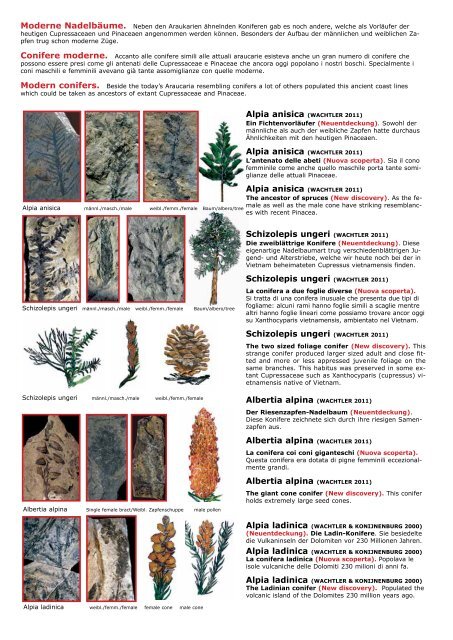Download PDF Entdeckungen - Wachtler
Download PDF Entdeckungen - Wachtler
Download PDF Entdeckungen - Wachtler
Create successful ePaper yourself
Turn your PDF publications into a flip-book with our unique Google optimized e-Paper software.
Moderne Nadelbäume. Neben den Araukarien ähnelnden Koniferen gab es noch andere, welche als Vorläufer der<br />
heutigen Cupressaceaen und Pinaceaen angenommen werden können. Besonders der Aufbau der männlichen und weiblichen Zapfen<br />
trug schon moderne Züge.<br />
Conifere moderne. Accanto alle conifere simili alle attuali araucarie esisteva anche un gran numero di conifere che<br />
possono essere presi come gli antenati delle Cupressaceae e Pinaceae che ancora oggi popolano i nostri boschi. Specialmente i<br />
coni maschili e femminili avevano già tante assomiglianze con quelle moderne.<br />
Modern conifers. Beside the today’s Araucaria resembling conifers a lot of others populated this ancient coast lines<br />
which could be taken as ancestors of extant Cupressaceae and Pinaceae.<br />
Alpia anisica (WACHTLER 2011)<br />
The ancestor of spruces (New discovery). As the fe-<br />
Alpia anisica<br />
male as well as the male cone have striking resemblanc-<br />
männl./masch./male weibl./femm./female Baum/albero/tree<br />
es with recent Pinacea.<br />
Schizolepis ungeri männl./masch./male weibl./femm./female Baum/albero/tree<br />
Schizolepis ungeri männl./masch./male weibl./femm./female<br />
Albertia alpina Single female bract/Weibl. Zapfenschuppe male pollen<br />
Alpia ladinica weibl./femm./female female cone male cone<br />
Alpia anisica (WACHTLER 2011)<br />
Ein Fichtenvorläufer (Neuentdeckung). Sowohl der<br />
männliche als auch der weibliche Zapfen hatte durchaus<br />
Ähnlichkeiten mit den heutigen Pinaceaen.<br />
Alpia anisica (WACHTLER 2011)<br />
L’antenato delle abeti (Nuova scoperta). Sia il cono<br />
femminile come anche quello maschile porta tante somiglianze<br />
delle attuali Pinaceae.<br />
Schizolepis ungeri (WACHTLER 2011)<br />
Die zweiblättrige Konifere (Neuentdeckung). Diese<br />
eigenartige Nadelbaumart trug verschiedenblättrigen Jugend-<br />
und Alterstriebe, welche wir heute noch bei der in<br />
Vietnam beheimateten Cupressus vietnamensis finden.<br />
Schizolepis ungeri (WACHTLER 2011)<br />
La conifera a due foglie diverse (Nuova scoperta).<br />
Si tratta di una conifera inusuale che presenta due tipi di<br />
fogliame: alcuni rami hanno foglie simili a scaglie mentre<br />
altri hanno foglie lineari come possiamo trovare ancor oggi<br />
su Xanthocyparis vietnamensis, ambientato nel Vietnam.<br />
Schizolepis ungeri (WACHTLER 2011)<br />
The two sized foliage conifer (New discovery). This<br />
strange conifer produced larger sized adult and close fitted<br />
and more or less appressed juvenile foliage on the<br />
same branches. This habitus was preserved in some extant<br />
Cupressaceae such as Xanthocyparis (cupressus) vietnamensis<br />
native of Vietnam.<br />
Albertia alpina (WACHTLER 2011)<br />
Der Riesenzapfen-Nadelbaum (Neuentdeckung).<br />
Diese Konifere zeichnete sich durch ihre riesigen Samenzapfen<br />
aus.<br />
Albertia alpina (WACHTLER 2011)<br />
La conifera coi coni giganteschi (Nuova scoperta).<br />
Questa conifera era dotata di pigne femminili eccezionalmente<br />
grandi.<br />
Albertia alpina (WACHTLER 2011)<br />
The giant cone conifer (New discovery). This conifer<br />
holds extremely large seed cones.<br />
Alpia ladinica (WACHTLER & KONIJNENBURG 2000)<br />
(Neuentdeckung). Die Ladin-Konifere. Sie besiedelte<br />
die Vulkaninseln der Dolomiten vor 230 Millionen Jahren.<br />
Alpia ladinica (WACHTLER & KONIJNENBURG 2000)<br />
La conifera ladinica (Nuova scoperta). Popolava le<br />
isole vulcaniche delle Dolomiti 230 milioni di anni fa.<br />
Alpia ladinica (WACHTLER & KONIJNENBURG 2000)<br />
The Ladinian conifer (New discovery). Populated the<br />
volcanic island of the Dolomites 230 million years ago.


